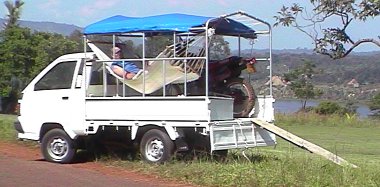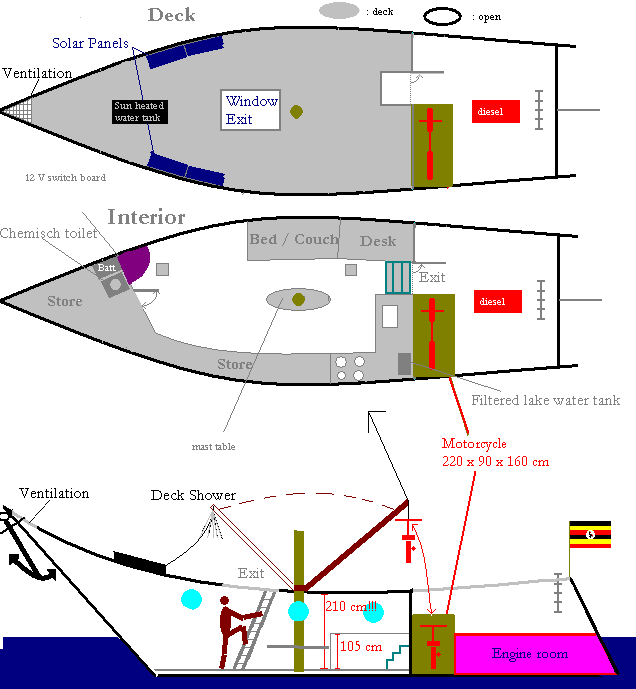
| Greetings Home |
| Previous Greeting |
| Next Greeting |
| Next Dhow Logbook |
Crtd 05-01-01 Lastedit 14-08-20
The Problem and the Idea
Start of the Dhow Building Logbooks
In July 2004 I left Europe for good. I moved to Jinja, Uganda. I had agreed to rent a banda which was to be built at the shore of lake Victoria near the source of the Nile, and would be ready at the time of my arrival. But when I drove to the place with my cross motorcycle I found it in the state depicted below:

I gave up the idea of waiting for the banda to be finished. So I rented a room in town and bought a little truck.

The truck was meant to be my mobile workshop for building a tradional Lake Victoria dhow, which should become my house-boat.
Dhows are ships built in Arab tradition, who, in turn got the basic idea from the ancient Egyptians.


The
dhow is the first standard type of sailing ship in history. Around 3000 BC
Egyptians ventured out of the Red Sea on the Indian Ocean to trade with the
African coastal peoples. The dhow can not sail in the wind. Beam reach (90o)
is the closest one can get. They have no plate or leeboard. Traditionally, on the Indian ocean one waited for
the season to change the reigning wind direction. The
dhow building and sailing arrived at the lake from the Indian Ocean harbor cities Dar es
Salaam and Mombassa far before any European knew about the existence of this
lake. Arabs knew East Africa and some knowledge of Arab language and visits to
Arab geographers would have made Stanley's and Livingstone's efforts
superfluous. More generally, everybody seems to have known the place before the
Europeans discovered it.
On Lake Victoria, the wind is largely dependent on temperature differences between land and
water. In the night and the morning, the wind flows in the direction of the lake
centre. At around eleven in the morning the land reaches the temperature of the
lake water and there is a lull. An hour or so later you will have wind from the
lake towards the land. This wind then gains some force and dies well after
sunset.. Sailing along the coast, the dhow will have its beam reach wind, albeit
from the land in the early morning and from the lake in the afternoon.

Trading and fishing
dhows moored
at the Mwanza harbor
beach market.
I made some plans to discuss with ship yards in Uganda:

The problem
was the bad quality of the traditional dhows I saw in Jinja (see picture below)

Proudly, Ugandan carpenters would say: "My dhows last for five years!".
| Greetings Home |
| Previous Greeting |
| Next Greeting |
| Next Dhow Logbook |